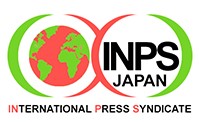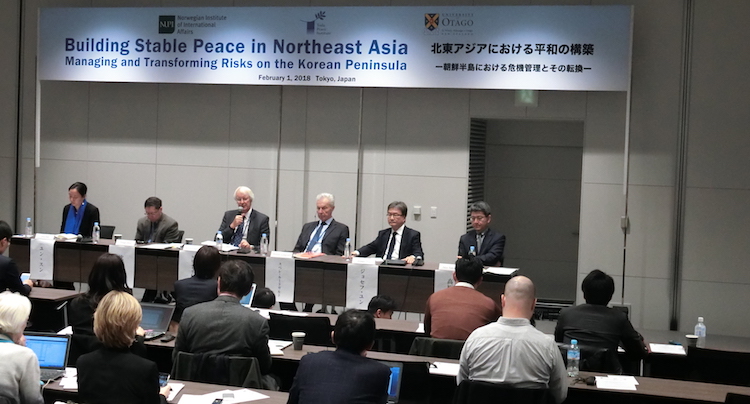By Katsuhiro Asagiri
TOKYO (IDN) – ‘Building Stable Peace in Northeast Asia: Managing and Transforming Risks on the Korean Peninsula’ was the subject of a colloquium in which regional experts on peace and security, policy makers and civil society organizations from the United States, China, South Korea and Japan participated against the backdrop of a volatile situation in the region.
In the run-up to North Korea claiming that it had conducted its first successful test of an intercontinental ballistic missile that can “reach anywhere in the world,” 1995 Nobel Peace Laureate Pugwash Conferences on Science and World Affairs expressed concern in a statement on May 4, 2017 that “the mounting confrontation with North Korea is raising grave dangers.” [P 37] JAPANESE TEXT VERSON PDF | KOREAN TEXT VERSON PDF
Some nine months later, on January 25, 2018, the iconic Doomsday Clock moved 30 seconds closer to midnight, the closest to the symbolic point of annihilation that the Clock has been since 1953 at the height of the Cold War.
This disquieting situation added to the importance of the colloquium co-organised by the The National Centre for Peace and Conflict Studies at the University of Otago, New Zealand, the Japanese think-tank Toda Peace Institute and the Norwegian Institute of International Affairs (NUPI) on February 1, 2018.
This Second Tokyo Colloquium identified in the face of geopolitical instability, “the forces generating insecurity, and turbulence” and analysed “impediments to diplomatic and negotiated responses to North Korean challenges.” Furthermore: “It focussed on ways in which existential nuclear threat can be dealt with through preventive diplomacy, negotiations and collaborative problem solving.”
Two panels of influential experts and policy makers shared their insight and wisdom on “dealing with security threats in Northeast Asia” and “managing risks in the Korean Peninsula, breaking the impasse with North Korea”.
Since the colloquium was held under Chatham House Rules, the press briefing by Kevin P. Clements, Director of Toda Peace Institute and Chair of the National Center for Peace and Conflict Studies, University of Otago conveyed a gist of discussions.
According to the Toda Peace Institute director Clemens, the first panel focused on “tensions and challenges in Northeast Asia generally and how to respond to those creatively and non-violently”. In particular, the panel looked on “how to improve on relations, among others, between China and Japan which is considered to be a major bilateral relationship critical to many of the issues that were on table.”
Clemens added: The panel also looked at what kinds of regional security architecture might be necessary for managing disputes non-violently, and focussed attention on how to build trust and respect between China and Japan, Japan and Korea, and between North and South Korea.
The major focus of the second panel, he said, was on North Korea’s nuclear threat and how to respond to that “creatively, non-violently and without a military strike”.
The panellists also scrutinised “a whole range of different options that were on the table – in terms of building confidence between North and South Korea, between North Korea and the United States, how to facilitate constructive negotiations between the U.S. and North Korea, and find ways in which all of the countries of Northeast Asia can begin working towards creating an environment within which the challenges facing the region posed by North Korea can be dealt with creatively internationally.”
Asked what was North Korea’s real intention, its strategic and tactical goals while continuing with nuclear build-up, Ambassador Joseph Yun, U.S. Special Representative for North Korea, who joined the briefing, said what his interlocutors in Pyongyang had communicated to him was that “they want security, they want economic prosperity, and so on.”
North Korea’s desire was for security and economic prosperity, affirmed Yun Sun, Senior Associate with the East Asia Program at the Stimson Center and a non-resident fellow at the Brookings Institution, China.
The North Koreans’ main objection, as they told Ambassador Yun, was “what they call U.S. hostile policies.” This was an occasion for him “to engage with them” and explain to them that the U.S. position had consistently been the disapproval of the “nuclearisation” of North Korea, its nuclear weapons”.
In an attempt to counter widespread speculation that a pre-emptive strike was Washington’s endgame, he said: “I don’t believe we are close to (a military strike), and I think we want to have credible negotiations. But we also have said, and we’ve been very consistent, that all options are on the table, and by all options, it has to include military options.”
These remarks came close on the heels of a former White House official who, once tipped to become the next U.S. envoy to South Korea, in a critical opinion piece in the Washington Post said that Washington’s “all options” pursuit was with the goal of delivering a “bloody nose” to North Korean leader Kim Jong-un.
“Some may argue that US casualties and even a wider war on the Korean Peninsula are risks worth taking, given what is at stake,” wrote Dr Victor Cha, a professor at Georgetown University and senior adviser at the Centre for Strategic and International Studies. “But a strike (even a large one) would only delay North Korea’s missile-building and nuclear programmes, which are buried in deep, unknown places impenetrable to bunker-busting bombs.”
U.S. Special Representative for North Korea, Ambassador Yun maintained that Washington’s “peaceful pressure” policy involved “very strongly piling on pressure as well as leaving the door open for a dialogue”, adding that the U.S. has a communication channel open with Pyongyang.
“Everybody wants to give diplomacy a good run,” he said, referring to talks between the two Koreas on the North’s participation in the Pyeongchang Winter Games in the South, which kicked off on February 9. Washington has also agreed to postpone until after the Games its annual joint Foal Eagle military exercises with South Korea, which Pyongyang sees as a dress rehearsal for invasion.
But Ambassador Yun cautioned that diplomacy is “not conducted by smoke signals”, and said the North had to make a firm commitment to stop provocation in order for the U.S. to agree to talks. U.S. President Donald Trump in his State of the Union address on January 30, said Pyongyang’s nuclear weapons might “very soon threaten” the U.S. mainland.
Against this backdrop, it was crucial to ensure that all countries imposed sanctions on the North as fully as possible to maximise pressure, he added.
While Beijing has already imposed sanctions on the trade of coal, iron ore, consumer goods and textiles, the U.S. and Japan have called on China time and again, as North Korea’s main economic benefactor, to do more to tighten the noose.
Ambassador Yun said: “We believe China has implemented the United Nations Security Council resolutions. But of course in terms of sanctions, there’re a number of things going on including smuggling and trade that the authorities don’t know about.”
Professor Shen Dingli, of Fudan University in Shanghai, and Yun Sun, of the Stimson Centre in Washington D.C., who also joined the briefing, pointed out that China had not cut off oil completely nor resolved issues such as the maritime interdiction of North Korean vessels as these have not been agreed under Security Council resolutions.
All the same, the general view among the colloquium participants reportedly was that UN sanctions have taken their toll on Pyongyang. This was indicated by North Korean leader Kim’s offer of his country to take part in the Olympic Games, widely regarded as an olive branch to Seoul. Also, North Korea’s winter military training has been smaller in scale.
The record 104 North Korean “ghost ships” that washed ashore in Japan in 2017 with 35 bodies and 42 survivors, also hinted at poor maintenance, fuel shortages, and a general desperation among fishermen, who are sailing further away, a colloquium participant indicated.
Stimson Centre’s Yun Sun indicated briefing the media that a standoff was likely after the Winter Olympics. “It is a matter of regime legitimacy and national pride. With North Korea so close to achieving credible ICBM (intercontinental ballistic missile) capability, for them to give it all up now seems improbable,” she said. [IDN-InDepthNews – 12 February 2018]
Photo: Toda Institute Director Kevin P. Clements briefing media on the Colloquium. Credit: Kotoe Asagiri | IDN-INPS


